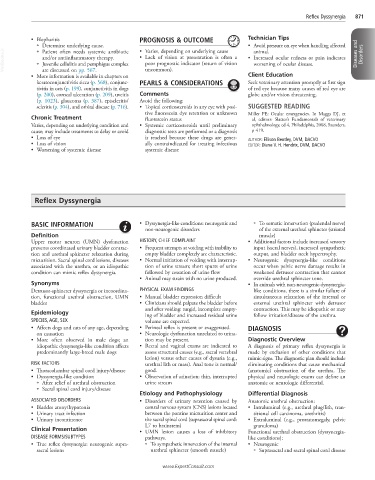Page 1732 - Cote clinical veterinary advisor dogs and cats 4th
P. 1732
Reflex Dyssynergia 871
• Blepharitis PROGNOSIS & OUTCOME Technician Tips
○ Determine underlying cause. • Varies, depending on underlying cause • Avoid pressure on eye when handling affected
VetBooks.ir ○ Juvenile cellulitis and pemphigus complex • Lack of vision at presentation is often a • Increased ocular redness or pain indicates Diseases and Disorders
○ Patient often needs systemic antibiotic
animal.
and/or antiinflammatory therapy.
poor prognostic indicator (return of vision
worsening of ocular disease.
are discussed on pp. 567.
• More information is available in chapters on uncommon). Client Education
keratoconjunctivitis sicca (p. 568), conjunc- PEARLS & CONSIDERATIONS Seek veterinary attention promptly at first sign
tivitis in cats (p. 199), conjunctivitis in dogs of red eye because many causes of red eye are
(p. 200), corneal ulceration (p. 209), uveitis Comments globe and/or vision threatening.
(p. 1023), glaucoma (p. 387), episcleritis/ Avoid the following:
scleritis (p. 304), and orbital disease (p. 716). • Topical corticosteroids in any eye with posi- SUGGESTED READING
tive fluorescein dye retention or unknown Miller PE: Ocular emergencies. In Maggs DJ, et
Chronic Treatment fluorescein status al, editors: Slatter’s Fundamentals of veterinary
Varies, depending on underlying condition and • Systemic corticosteroids until preliminary ophthalmology, ed 4, Philadelphia, 2008, Saunders,
cause; may include treatments to delay or avoid diagnostic tests are performed or a diagnosis p 419.
• Loss of eye is reached because these drugs are gener- AUTHOR: Ellison Bentley, DVM, DACVO
• Loss of vision ally contraindicated for treating infectious EDITOR: Diane V. H. Hendrix, DVM, DACVO
• Worsening of systemic disease systemic disease
Reflex Dyssynergia
BASIC INFORMATION • Dyssynergia-like conditions: neurogenic and ○ To somatic innervation (pudendal nerve)
non-neurogenic disorders of the external urethral sphincter (striated
Definition muscle)
Upper motor neuron (UMN) dysfunction HISTORY, CHIEF COMPLAINT • Additional factors include increased sensory
prevents coordinated urinary bladder contrac- • Frequent attempts at voiding with inability to input (sacral nerves), increased sympathetic
tion and urethral sphincter relaxation during empty bladder completely are characteristic. output, and bladder neck hypertrophy.
micturition. Sacral spinal cord lesions, diseases • Normal initiation of voiding with interrup- • Neurogenic dyssynergia-like conditions
associated with the urethra, or an idiopathic tion of urine stream; short spurts of urine occur when pelvic nerve damage results in
condition can mimic reflex dyssynergia. followed by cessation of urine flow weakened detrusor contraction that cannot
• Animal may strain with no urine produced. override urethral sphincter tone.
Synonyms • In animals with non-neurogenic dyssynergia-
Detrusor-sphincter dyssynergia or incoordina- PHYSICAL EXAM FINDINGS like conditions, there is a similar failure of
tion, functional urethral obstruction, UMN • Manual bladder expression difficult simultaneous relaxation of the internal or
bladder • Clinicians should palpate the bladder before external urethral sphincter with detrusor
and after voiding: turgid, incomplete empty- contraction. This may be idiopathic or may
Epidemiology ing of bladder and increased residual urine follow irritation/disease of the urethra.
SPECIES, AGE, SEX volume are expected.
• Affects dogs and cats of any age, depending • Perineal reflex is present or exaggerated. DIAGNOSIS
on causation • Neurologic dysfunction unrelated to urina-
• More often observed in male dogs; an tion may be present. Diagnostic Overview
idiopathic dyssynergia-like condition affects • Rectal and vaginal exams are indicated to A diagnosis of primary reflex dyssynergia is
predominantly large-breed male dogs assess structural causes (e.g., sacral vertebral made by exclusion of other conditions that
lesion) versus other causes of dysuria (e.g., mimic signs. The diagnostic plan should include
RISK FACTORS urethral lith or mass). Anal tone is normal/ eliminating conditions that cause mechanical
• Thoracolumbar spinal cord injury/disease good. (anatomic) obstruction of the urethra. The
• Dyssynergia-like condition • Observation of urination: thin, interrupted physical and neurologic exams can define an
○ After relief of urethral obstruction urine stream anatomic or neurologic differential.
○ Sacral spinal cord injury/disease
Etiology and Pathophysiology Differential Diagnosis
ASSOCIATED DISORDERS • Disorders of urinary retention caused by Anatomic urethral obstruction:
• Bladder atony/hypotonia central nervous system (CNS) lesions located • Intraluminal (e.g., urethral plug/lith, tran-
• Urinary tract infection between the pontine micturition center and sitional cell carcinoma, urethritis)
• Urinary incontinence the sacral spinal cord (suprasacral spinal cord: • Extraluminal (e.g., prostatomegaly, pelvic
L7 to brainstem) granuloma)
Clinical Presentation • UMN lesion causes a loss of inhibitory Functional urethral obstruction (dyssynergia-
DISEASE FORMS/SUBTYPES pathways. like conditions):
• True reflex dyssynergia: neurogenic supra- ○ To sympathetic innervation of the internal • Neurogenic
sacral lesions urethral sphincter (smooth muscle) ○ Suprasacral and sacral spinal cord disease
www.ExpertConsult.com

